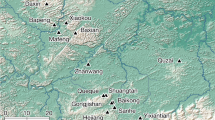Abstract
Though the African clawed frog (Xenopus laevis) is the most commonly used amphibian in biological research, there are no standard protocols for the husbandry of this species. With the goal of developing optimal conditions for raising these frogs, the authors assessed the effects of available cover and feeding schedule on post-metamorphic growth and behavior of juvenile X. laevis. Frogs, which were housed four per tank, had access to varying numbers of shelters (zero, two or four) and were fed either daily or episodically (three times per week) over a period of 6 months. Though X. laevis growth was not influenced by the availability of cover, frogs that were fed daily grew larger than frogs that were fed episodically. Additionally, frogs that were fed daily and had no access to cover were most likely to exhibit foraging behavior when disturbed. These results suggest that feeding frogs daily will promote growth and fecundity. Furthermore, although labs often provide frogs with hiding places, such cover does not enhance X. laevis growth.
This is a preview of subscription content, access via your institution
Access options
Subscribe to this journal
We are sorry, but there is no personal subscription option available for your country.
Buy this article
- Purchase on Springer Link
- Instant access to full article PDF
Prices may be subject to local taxes which are calculated during checkout

Similar content being viewed by others
References
Dawid, I.B. & Sargent, T.D. Xenopus laevis in developmental and molecular biology. Science 240, 1443–1448 (1988).
Major, N. & Wassersug, R.J. Survey of current techniques in the care and maintenance of the African clawed frog (Xenopus laevis). Contemp. Top. Lab. Anim. Sci. 37, 57–60 (1998).
Trueb, L. in Grzimek's Animal Life Encyclopedia Vol. 6 2nd edn. (eds. Hutchins, M., Duellman, W.E. & Schlager, N.) 99–102 (Gale Group, Farmington Hills, MI, 2003).
Tinsley, R.C., Loumont, C. & Kobel, H.R. in The Biology of Xenopus (eds. Tinsley, R.C. & Kobel, H.R.) 35–59 (Oxford University Press, Inc., New York, 1996).
Savage, R.M. The natural stimulus for spawning in Xenopus laevis (Amphibia). J. Zool. (Lond.) 165, 245–260 (1971).
Kaplan, M.L. An enriched environment for the African clawed frog (Xenopus laevis). Lab Anim. (NY) 22, 25–29 (1993).
Hilken, G., Dimigen, J. & Igluaer, F. Growth of Xenopus laevis under different laboratory rearing conditions. Lab. Anim. 29, 152–162 (1995).
Brown, M.J. & Nixon, R.M. Enrichment for a captive environment – The Xenopus laevis. Anim. Tech. Wel. 3, 87–95 (2004).
Reed, B.T. Guidance for the housing and care of the African clawed frog, Xenopus laevis. RSPCA || Xenopus [online] http://www.rspca.org.uk/xenopus/ (2005).
Wassersug, R. in The Biology of Xenopus (eds. Tinsley, R.C. & Kobel, H.R.) 195–211 (Oxford University Press, Inc., New York, 1996).
Canadian Council on Animal Care. Guide to the Care and Use of Experimental Animals Vol. 2 (Canadian Council on Animal Care, Ottawa, ON, Canada, 1984).
Gray, L.A., O'Reilly, J.C. & Nishikawa, K.C. Evolution of forelimb movement patterns for prey manipulation in anurans. J. Exp. Zool. 277, 417–424 (1997).
Emerson, S. & De Jongh, H.J. Muscle activity at the ilio-sacral articulation of frogs. J. Morphol. 166, 129–144 (1980).
Secor, S.M. Physiological responses to feeding, fasting and estivation for anurans. J. Exp. Biol. 208, 2595–2608 (2005).
Secor, S.M. Evolutionary and cellular mechanisms regulating intestinal performance of amphibians and reptiles. Integr. Comp. Biol. 45, 282–294 (2005).
Elepfandt, A. in The Biology of Xenopus (eds. Tinsley, R.C. & Kobel, H.R.) 97–120 (Oxford University Press, Inc., New York, 1996).
Canadian Council on Animal Care. Guide to the Care and Use of Experimental Animals Vol. 1 2nd edn. (Canadian Council on Animal Care, Ottawa, ON, Canada, 1993).
Acknowledgements
We thank K. Sullivan for his assistance with animal care, and G. Handrigan, J. Phillips, R. Tinsley and S. Adamo for critical feedback on draft manuscripts. Greg Handrigan also provided insight into methods for raising and breeding Xenopus. This research was supported by a Natural Sciences and Engineering Research Canada operating grant to R.J.W.
Author information
Authors and Affiliations
Corresponding author
Ethics declarations
Competing interests
The authors declare no competing financial interests.
Rights and permissions
About this article
Cite this article
Gouchie, G., Roberts, L. & Wassersug, R. Effects of available cover and feeding schedule on the behavior and growth of the juvenile African clawed frog (Xenopus laevis). Lab Anim 37, 165–169 (2008). https://doi.org/10.1038/laban0408-165
Received:
Accepted:
Issue Date:
DOI: https://doi.org/10.1038/laban0408-165
This article is cited by
-
Color and intensity discrimination in Xenopus laevis tadpoles
Animal Cognition (2016)
-
The effect of mirrors on African clawed frog (Xenopus laevis) larval growth, development, and behavior
Behavioral Ecology and Sociobiology (2008)



